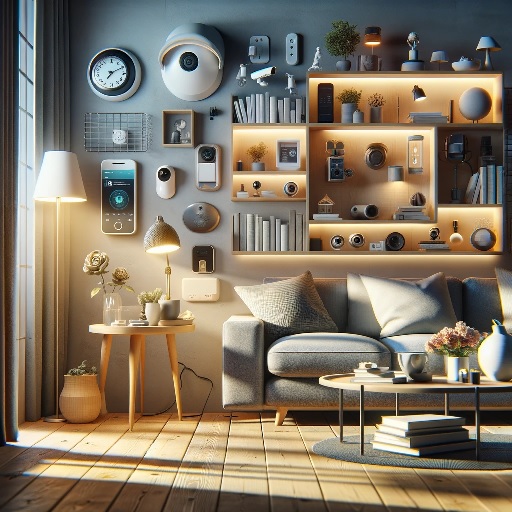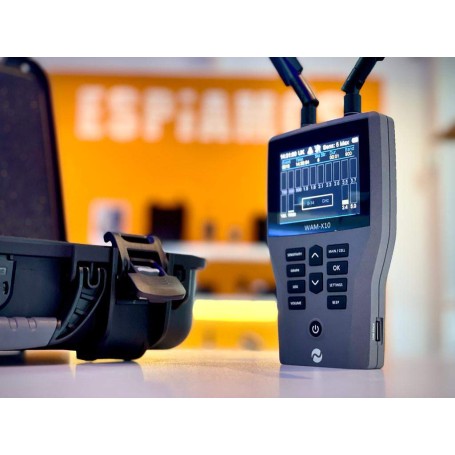In today's digital age, our privacy is under constant scrutiny. With technological advancement, the ability to spy on others has reached unprecedented levels, making unwanted surveillance a growing concern. From private conversations to intimate moments, nothing seems to be off limits to unwanted eyes and ears. Fortunately, technology also offers us tools to protect ourselves from these intrusions. This article will guide you through effective methods to detect hidden cameras and microphones , ensuring your privacy remains protected.

Perform a Physical Search
Before turning to advanced technological solutions, a good starting point is to perform a thorough visual inspection of your environment. This initial search can be surprisingly effective in identifying surveillance devices. Below we detail practical steps to help you in this process:
use your eyes
Careful observation is your first defense tool. Pay attention to objects and decorations that seem out of place or that you don't remember placing. Recording devices, although small, need some exposure to capture audio and video effectively. This means that they can often be detected by visual inspection. Look for loose wires, small holes in decorative objects, or anything that appears to have a dubious purpose.
Check electronic devices
Common electronic devices, such as smoke detectors, lamps, and speakers, offer ideal hiding places for microphones and cameras due to their constant electrical connection. Carefully disassemble these devices to inspect their interior. Look not only for cameras and microphones, but also for non-standard modifications, such as additional circuitry or unexpected cables that could indicate the presence of a recording device.
Attention to decorations
Decorative elements are frequently used to hide spy devices such as mini spy cameras . Look carefully at vases, photo frames, stuffed animals, or any item that offers a compartment to hide something small. Even hanging decorations, such as paintings or mirrors, can harbor hidden cameras. Be especially vigilant with objects that have a clear view of the spaces where you spend most of your time.
peculiar cables
Finally, take note of any cables that don't seem to have a clear purpose or don't terminate at a known device. Some spy devices require external power to operate continuously. If you find cables that appear to be powering "nothing," it could be a sign that you're looking at a hidden device. These cables can often be traced back to their source, revealing the location of cameras or microphones.
Search for Electrical and RF Signals
If you still have suspicions after performing a thorough visual inspection, it's time to take a more technological approach. Spy devices, such as hidden cameras and microphones, emit RF (radio frequency) signals or rely on electrical connections that can be detected with the appropriate equipment. Here's how to use these tools to find hidden recording devices.
RF Detector
Radio frequency detectors are essential tools in the search for spy devices. These devices are capable of identifying radio frequency signals emitted by hidden microphones and cameras. By sweeping your home or office with an RF detector, you can locate suspicious signal sources. It is important to conduct this search methodically, covering all areas and paying special attention to those places where a visual inspection revealed nothing. The presence of strong RF signals in unusual locations can be a clear indicator of a recording device.

Call interference
Another useful technique is to pay attention to interference during phone calls. Eavesdropping devices often generate electromagnetic fields that can cause audible interference on the line. Listen carefully for any unusual noises, such as humming, clicking, or creaking, as you move through different areas of your space. These anomalies can signal proximity to a hidden microphone or camera, helping you identify potential points of concern.
Digital cameras and smartphones
Modern technology has provided us with a surprisingly effective tool that many of us carry in our pockets: the smartphone. Digital cameras and smartphones are capable of detecting infrared light, which is invisible to the human eye but commonly used by hidden cameras to record in low light conditions. By turning off the lights and looking through your device's camera, you can look for flashes or bright spots that would indicate the presence of a camera. This method is simple, but can be extremely effective in discovering hidden cameras in your environment.
Using these advanced detection techniques can make the difference between discovering a hidden recording device and missing a threat to your privacy. Although they require a little more effort and possibly investment in specialized tools, the peace of mind they provide is invaluable.
Do you think the government is spying on you?
Concern about being the target of a government investigation is understandable in the current climate of global surveillance. Intelligence agencies have a wide range of advanced technological tools at their disposal, which can make it seem impossible to protect your privacy. It is important to recognize that while technology has advanced, there are also steps you can take to safeguard your personal information.
It is a fact that everyday devices such as smartphones and computers can be used to monitor individuals. These devices contain significant amounts of personal information and are capable of transmitting data, often without the user's knowledge. However, there are practices you can adopt to minimize the risks:
- Security Updates: Keep your devices up to date with the latest security updates. Software makers often release patches for vulnerabilities that could be exploited for surveillance.
- Using a VPN: Use a virtual private network (VPN) to encrypt your internet traffic, making it difficult for third parties to intercept your data.
- Minimize your digital footprint: Be aware of the information you share online and minimize your digital footprint as much as possible.
- Strong security practices: Employ strong passwords, two-factor authentication, and physical security measures to protect your devices.
While it's true that traditional counterespionage devices may offer little relief from government surveillance, taking a proactive approach to protecting your personal information can make a big difference. Remember, education and caution are your best allies in protecting your privacy.
Finally, it is important to maintain a balanced perspective. While we should be cautious and take steps to protect our privacy, we should also avoid falling into fear or paranoia. Most people are not direct targets of government surveillance, but adopting good privacy practices is a win-win for everyone.
Other articles of interest:
- How to detect hidden microphones with your cell phone?
- How to know if there are spy cameras in a hotel room?
- Find out if there are hidden camouflaged cameras in your home.
Frequently Asked Questions on How to Detect Hidden Cameras and Microphones
How do I know if I am being spied on with hidden cameras or microphones?
Some signs may include the presence of unfamiliar or out-of-place objects in your environment, interference or strange noises in electronic devices, and unusual behavior of your Internet-connected devices. Performing a detailed physical inspection and using RF detectors are effective methods for discovering spy devices.
Can hidden cameras operate in complete darkness?
Yes, many modern hidden cameras can operate in low light conditions or even complete darkness using infrared night vision technology. You can detect these cameras by looking for flashes or bright spots through a smartphone camera in a dark environment.
What should I do if I find a hidden camera or microphone?
If you discover a spy device on your property without your consent, document the discovery with photographs, avoid handling the device more than necessary, and contact local authorities to report the invasion of privacy. In some cases, it may also be advisable to seek legal advice.
Is it legal to sell or possess counter-surveillance devices?
In most jurisdictions, owning and using counter-surveillance devices to protect your own privacy is legal. However, the sale and use of these devices may be subject to specific regulations. It is always advisable to review local laws before purchasing or using this equipment.
How can I protect my home from unwanted surveillance?
To protect your home, consider conducting regular inspections for spy devices, use curtains or blinds to block views into your home, secure your Wi-Fi network with a strong password and strong encryption, and limit the amount of personal information you share online.
Can RF detectors find all types of hidden cameras and microphones?
Although RF detectors are powerful tools, they may not detect all spy devices, especially those that do not continuously emit RF signals or that use advanced cloaking technologies. For complete protection, consider supplementing the use of RF detectors with visual inspections and other security measures.
Can my phone be used as a spy device without my knowledge?
Yes, it is possible for a smartphone to be compromised to spy on the user through malware or spy apps. To mitigate this risk, keep your operating system and apps up to date, download apps only from trusted sources, and consider installing a reputable mobile security solution.






 WhatsApp
WhatsApp Telegram
Telegram


